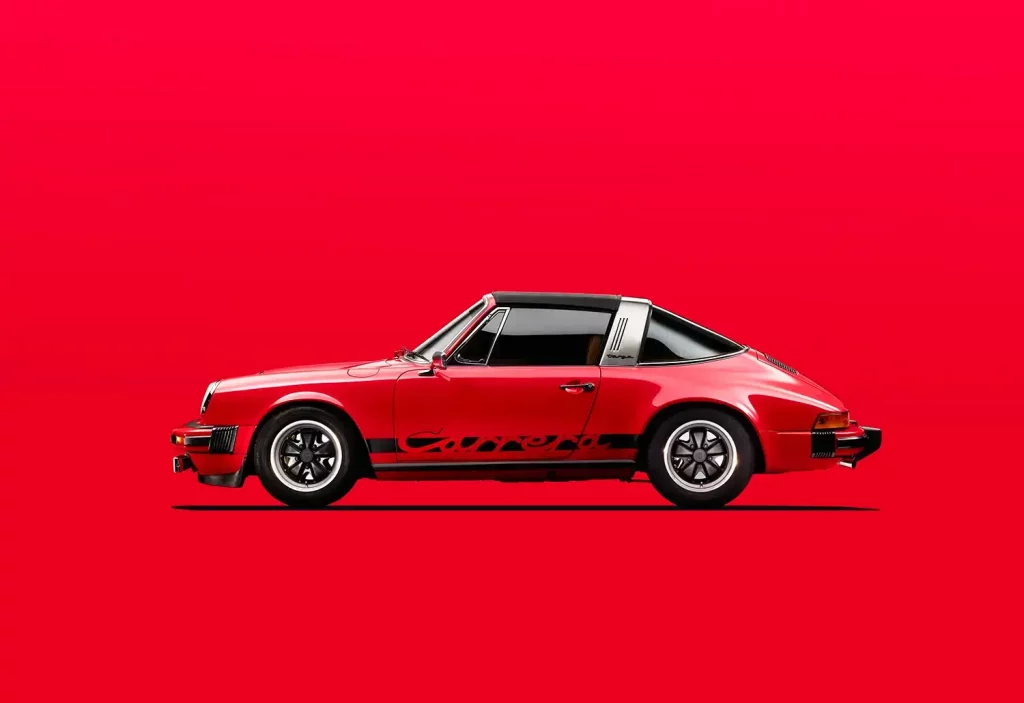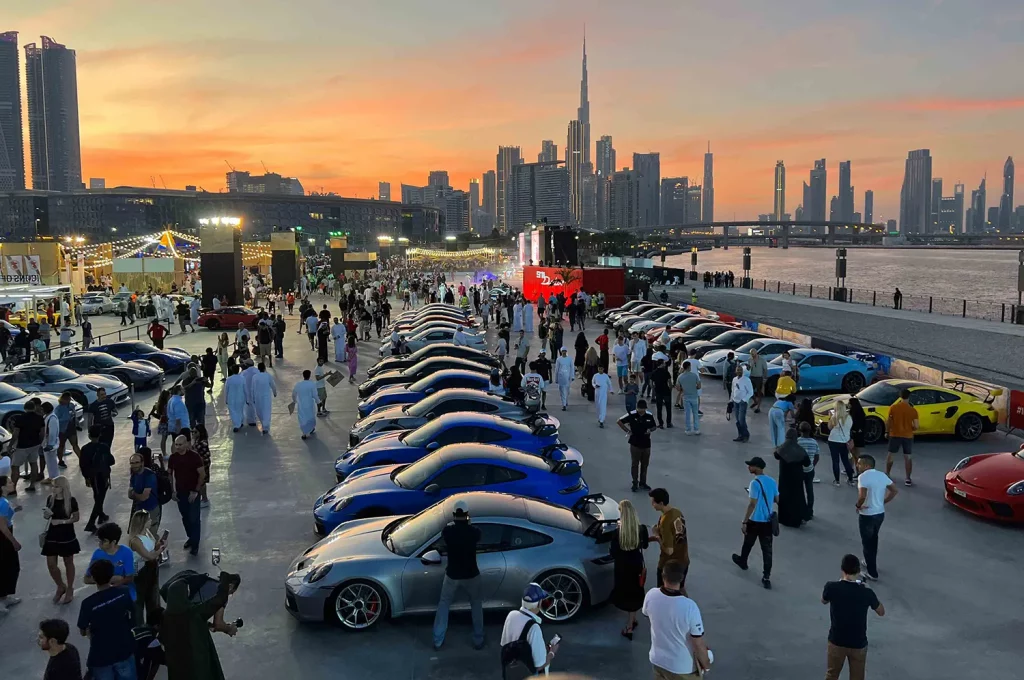
Porsche 911 Targa
Picture of the month Porsche 911 2.7 MFI Targa It looks like a completely “normal” Porsche G-model, but has 210 hp under the hood –

It all started with a shoot on a remote, small Atlantic island exactly 50 years ago: My pictures ended up in all the travel brochures, Fuerteventura became a vacation destination – and by “jumping over the dunes” I was a car photographer.
My first professional car shoot came about by happy accident when I was 21.
At that time, I had already completed my training as a photographer and was working in a photo studio in Stuttgart, Foto Krauss, where I mainly took passport photos and sold rolls of film.
Then one day a customer came into the store – it was 1972, exactly fifty years ago – and asked for the most expensive camera we carried. “The best you have in stock – and all the accessories.”
Of course, that gave me a tidy commission, so I packed him the most expensive thing we had there. A camera that was basically way too professional and way too expensive for this business.
Foto Krauss was a good photo store, but actually for good amateurs – not for professionals. And there we had a professional camera that had become a slow seller.
No wonder: it cost 25,000 marks.
A Porsche cost 24,800 marks back then – just for comparison, what a bullet of a camera it was.
The customer asked that I bring the camera and accessories to his company at 2 pm. So at two o’clock I stood in his secretary’s office, which was as busy as in a movie – and waited. And waited. And waited.

“The best you have in stock – and all the accessories.”
My boss had been annoyed anyway that the customer hadn’t paid for the camera right away and taken it with him, and that I should bring it to him. And as I sat there in the secretary’s office and the minutes ticked by, I was starting to sweat.
I imagined that everyone would already be waiting for me at the photo store, and the check wasn’t there, and maybe they would think I had stormed off with the check….
Anyway, after an hour, the man came out of his board office and just said in passing, “Oh, you’re still sitting there. I don’t have time now… come down to the car with me quickly.”
And I ran down beside him into the garage and was suddenly sitting in his Opel V8 Diplomat with all the cardboard crap on my lap, and he said, “Please don’t try to explain the camera to me now, I still have calls to make.”
(He already had a car phone at that time, I still have the number in my head – 58243. At that time you had to call the telecommunications office, “Hello, telecommunications office, please make me a line to Sowieso”).
Twenty minutes later we were standing at the airport, a barrier went up in front of us, and there I am looking up at this giant plane, his private jet, and asking him: Where should I put the camera now?
“Don’t babble on, bring up the camera,” he said, and I don’t know how it happened, anyway, at some point the doors are closed, the engines start, the plane takes off, and four hours later we land somewhere in the Atlantic on an island that nobody in Germany knew about.
On the way, of course, I had had time to set everything up nicely, load film and so on, and after two hours the customer came to me and said, “You know what, you can operate this much better, why don’t you take the photos?”
Because this customer was a visionary – like Elon Musk today.
This man had set out to develop a small, unknown island in the Atlantic Ocean, just off the coast of Africa, for tourism.
We are expanding the airport, we are building hotels, we are developing that. That was his plan.
And so, in 1972, this man brought the first people to vacation in Fuerteventura.

“Don’t babble, bring up the camera.”
I didn’t even try it. I never went back to the photo store. Instead, I made a roundabout effort to get to the owner of the chain store. Dr. Krauss, I announced, I am coming to confession.
I got an appointment right away. And there I sat, with my sunburned skin peeling off everywhere – because of course I hadn’t brought any sunscreen with me to Fuerteventura when I had flown off so spontaneously with the developer.
“Now I’m excited,” Dr. Krauss said.
I simply told him how it had been, and he kindly released me from my work contract immediately. He liked my story – we became friends over it, to this day.

“How do we get cool people now?” he asked. And I said by offering cool actions.
On Fuerteventura it went on so that I was on the road with the real estate developer and photographed properties, and when the first eighty apartments stood, he asked, how do we get cool people here now? And I said by offering cool promotions here.
It all started at Christmas, with the “biggest fir tree in the world”. It wasn’t the biggest, of course, because there was only six meters eighty in the cargo hold of the plane, but no matter – I flew a Christmas tree down there with Condor, and we celebrated Christmas, under the sun at 30 degrees.
>> Reading tip: Mille Miglia & more – the most important vintage car meetings for me
In addition to the actual Christmas, of course, we needed several highlights, so I suggested that on Christmas Day we take the hotel bus to a lonely bay to eat mussels – which was a lie in that on Fuerteventura at that time every bay was lonely.

“It was clear to me right away: We need a buggy, for these dunes.“
But we actually went to a cove and we were all knee deep in water and we collected shells from the rocks, and then we made a campfire, and we had baskets of dishes and spices and fresh water with us, and so we made a brew and cooked the shells in there. And it was accompanied by nice cool white wine with ice cubes – people went crazy with enthusiasm.
Then came windsurfing. Windsurfing had only come up a few years before, and we got boards for Fuerteventura, got some pros, taught vacationers how to surf – and put the cool surf pictures in the next travel brochure.
So on the one hand I developed ideas with the people on site and on the other hand I took pictures of everything. And the providers then used them to advertise.
You can’t even imagine it today, because there are pictures of everything. But at that time, from Fuerteventura, there was no picture material at all. Nobody even knew where and what Fuerteventura was in the 70’s.And then came the dunes.
There were such great dunes there, it’s incredible. Real shifting sand dunes… I had never seen anything like it. It was clear to me right away: we need a buggy, and we’ll use it to drive over the dunes.
I only found out half a year later that you could also jump over the dunes with it.
That’s how long it took to get the Beach Buggy down there.
From the company immediately someone went and bought this buggy from Belgium. And then you had to get it down there first.
At that time there was no cell phone, not even fax, only telex and radio, and you had to drive the buggy down to Seville or Cadiz in southern Spain for three days and then take the ferry to Gran Canaria, and then wait for days until there was a ferry from there to Fuerteventura, and then wait there for another two days somewhere until the gas station was open because the tanker didn’t come… that was quite an adventure.

“It took six months to get the buggy to the island.”
The “Leap over the Dune” from 1972 became my first professional car picture.
This has already given a boost to the island. I have seen my Fuerteventura pictures at that time in each travel brochure, one could book then also immediately over Karstadt, Kaufhof, Neckermann. The island was then everywhere in the program.
That was a great story for me, and I ended up working for the developer on a salaried basis. I had his complete trust and experienced great things. That is a time that has shaped me very much.
>> The best of five decades of car photography
“My Fuerteventura pictures ended up in all the travel brochures. travel brochures, and the ‘jump over the dune’ became became my first professional car picture.”

Picture of the month Porsche 911 2.7 MFI Targa It looks like a completely “normal” Porsche G-model, but has 210 hp under the hood –

It is probably the most exclusive Porsche meeting in the world, definitely the largest automobile festival in the Middle East – the Icons of Porsche

More of the same? Then get my mails
Now that I’m out of the operational business of Staud Studios, I finally have time for all my projects – books, exhibitions, lectures… Sign up with me, and I’ll keep you updated once or twice a month.